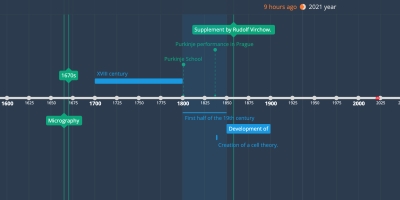Development of cell theory in the second half of the 19th century (1 jan 1850 ano – 1 jan 1900 ano)
Descrição:
Since the 1840s of the nineteenth century, the idea of the cell has been at the center of all biology's attention and has been quickly expanding, becoming an autonomous field of study - cytology.The cell theory's extension to protists (protozoa), which were recognized as free-living cells, was critical for its further development (Sibold, 1848).
At this point, the concept of the cell's composition shifts. The secondary importance of the cell membrane, which was previously recognized as the most important part of the cell, is clarified, as is the importance of protoplasm (cytoplasm) and the nucleus of cells (Moll, Cohn, L.S.Tsenkovsky, Leydig, Huxley), which found expression in M. Schulze's definition of a cell in 1861: A cell is a lump of protoplasm with a nucleus inside.
In 1861, Bryukko proposed a theory of the complicated structure of a cell, which he characterizes as a "elementary organism," and clarifies Schleiden and Schwann's hypothesis of cell development from a structureless substance (cytoblastoma). Cell division was discovered to be the technique of generation of new cells, which was first researched on filamentous algae by Mole. The researches of Negeli and N.I. Zhele were crucial in refuting the notion of cytoblastema on botanical material.
Remak discovered the division of tissue cells in mammals in 1841. It was discovered that blastomere cleavage is a succession of sequential divisions (Bishtyuf, N.A. Kelliker). R. Virchow set the idea of the general spread of cell division as a means for the generation of new cells in the form of an aphorism:
"Omnis cellula ex cellula."
Every cell is made up of cells.
Contradictions emerge strongly in the development of cell theory in the nineteenth century, indicating the dual nature of the cellular theory, which developed within the framework of the mechanical view of nature. Already in Schwann, there is an attempt to think of the organism as a collection of cells. This trend is particularly pronounced in Virchow's Cellular Pathology (1858).
Adicionado na linha do tempo:
Data:
1 jan 1850 ano
1 jan 1900 ano
~ 50 years
